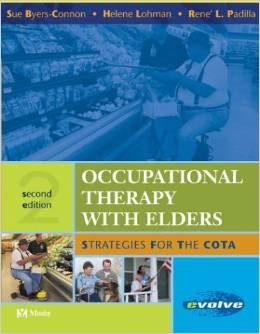|
|
|
| |
 |
|
|

|
 推薦指數:
推薦指數:





|
|
- 內容介紹
|
Occupational Therapy with Elders: Strategies for the COTA, 2e Hardcover – May 21, 2004
by Sue Byers-Connon (Author), Helene Lohman (Author), Rene Padilla (Author) & 1 more
ISBN-13: 978-0323024303
ISBN-10: 0323024300
This unique resource clearly presents a comprehensive range of elder care strategies and insights for the COTA. Coverage includes important trends, concepts and theories related to aging, as well as professional issues for occupational therapy professionals. A multi-disciplinary approach demonstrates the importance of the collaboration between the Occupational Therapist, Registered (OTR), and COTA.
Highlights the importance of COTAs to the care of elder patients.
Key terms, chapter objectives, and review questions highlight key chapter content.
Case Studies illustrate important principles and help readers apply what they've learned to actual situations.
Reduces the stereotypical role of dependent patients and dispels myths about aging.
Reflects the recently adopted Occupational Therapy Practice Framework and its interpretation when caring for elder patients.
AARP statistics and AOTA documents have been updated to reflect current information.
New photos have been added to enhance the material presented.
The appendix on web resources is now divided by chapter and includes a brief description of each website.
Features a new Evolve site with review questions and answers, web links, and much more.
New cases studies and review questions are included in each chapter.
Practice settings coverage has been expanded to cover traditional, non-traditional and assisted living facilities.
The hospice chapter features new guidelines on effective communication with elders.
The Aging Trends and Concepts chapter includes a discussion of the growing number of elder Americans living over the age of one hundred.
The principle of "thriving" is introduced and discussed in the Social and Biological Theories of Aging chapter.
In the chapter on Psychological Aspects of Aging, the need for elder social support is introduced and discussed, as is the principle of physical illness in relation to coping with a chronic disease or serious illness.
Features an extended and updated discussion of Medicare, Federal Public Policies, and other public sources of funding and how they relate to COTA practice. Other rehabilitation services and coverage concepts are discussed in relation to Federal Health Care Policy.
The Occupational Theories with Elders chapter introduces the Occupational Therapy Practice Framework and presents several new scenarios that illustrate the framework in use.
The chapter on sexuality in elders was expanded to include a specific discussion of elder homosexuals.
A new section on wheelchair seating and positioning was added to the mobility chapter.
Discusses decreased acuity and oculomotor dysfunction, and includes an in-depth presentation of the settings in which visual impairments are addressed.
Features the latest information on arthritis therapy and total knee replacement.
|
|
|

